2003 PONTIAC BONNEVILLE spare wheel
[x] Cancel search: spare wheelPage 261 of 418
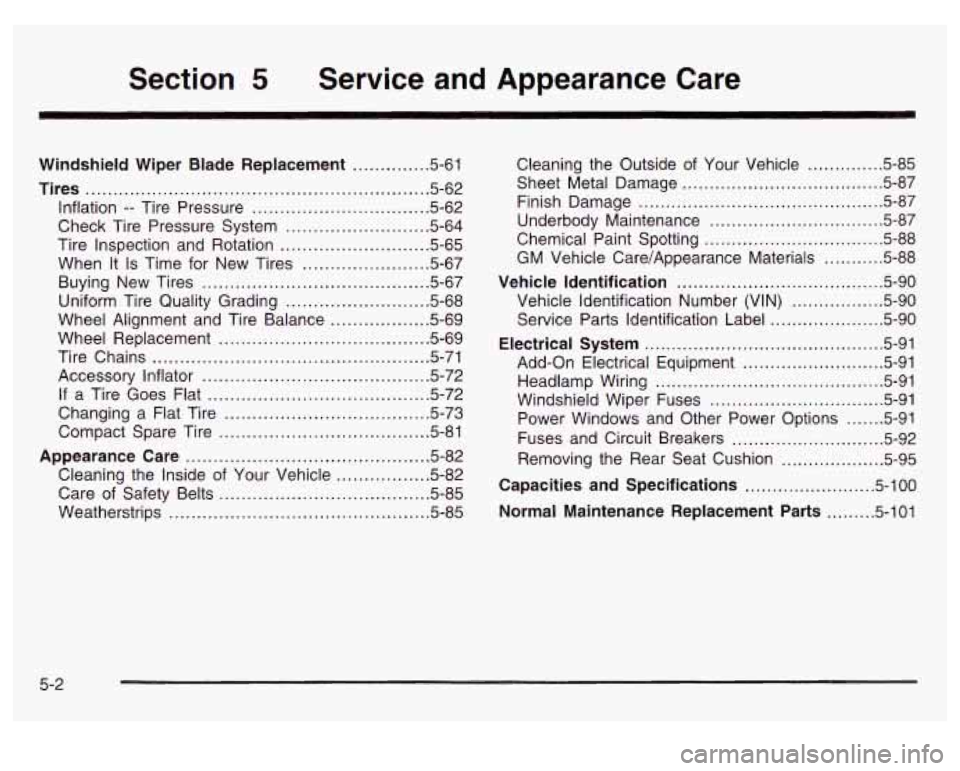
Section 5 Service and Appearance Care
Windshield Wiper Blade Replacement ............. 5-61
Tires .............................................................. 5.62
Inflation
.. Tire Pressure ................................ 5.62
Check Tire Pressure System
.......................... 5.64
Tire Inspection and Rotation
........................... 5.65
When It
Is Time for New Tires ....................... 5-67
Buying New Tires
........................................ 5-67
Uniform Tire Quality Grading
.......................... 5.68
Wheel Replacement
...................................... 5.69
Tire Chains
.................................................. 5-71
Accessory Inflator
......................................... 5.72
If a Tire Goes Flat ........................................ 5.72
Changing a Flat Tire
..................................... 5.73
Compact Spare Tire
..................................... 5-81
Appearance Care ............................................ 5.82
Wheel
Alignment and Tire Balance
.................. 5-69
Cleaning the Inside of Your Vehicle
................. 5-82
Care of Safety Belts
...................................... 5-85
Weatherstrips ............................................... 5.85
Cleaning the Outside of Your Vehicle .............. 5-85
Sheet Metal Damage
..................................... 5.87
Finish Damage
............................................. 5.87
Underbody Maintenance
................... ...... 5.87
Chemical Paint Spotting
................................. 5.88
Vehicle Identification ..................................... 5-90
Vehicle Identification Number (VIN)
...... ., ...... 5-90
Service Parts Identification Label
........ ...... 5-90
Electrical System ............................... ...... 5-91
Add-on Electrical Equipment
................ , ...... 5-91
Headlamp Wiring
.......................................... 5-91
Windshield Wiper Fuses
................................ 5-91
Power Windows and Other Power Options
....... 5-91
Fuses and Circuit Breakers
............................ 5-92
Removing the Rear Seat Cushion
................... 5-95
Capacities and Specifications ........................ 5-100
Normal Maintenance Replacement Parts ......... 5-101
GM Vehicle Care/Appearance Materials .......... 5.88
5-2
Page 325 of 418
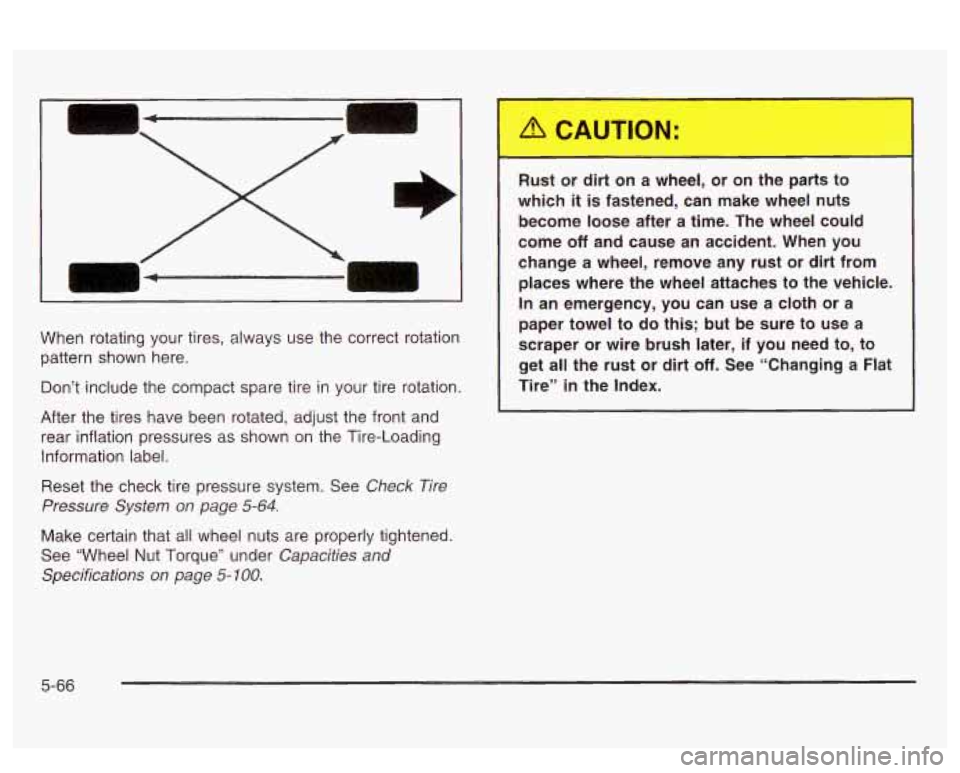
When rotating your tires, always use the correct rotation
pattern shown here.
Don’t include the compact spare tire in your tire rotation.
After the tires have been rotated, adjust the front and
rear inflation pressures as shown on the Tire-Loading
Information label.
Reset the check tire pressure system. See
Check Tire
Pressure System on page
5-64.
Make certain that all wheel nuts are properly tightened.
See “Wheel Nut Torque” under
Capacities and
Specifications on page
5- 100.
Rust or dirt on a wheel, or on the parts to
which
it is fastened, can make wheel nuts
become loose after a time. The wheel could
come
off and cause an accident. When you
change a wheel, remove any rust or dirt from
places where the wheel attaches to
the vehicle.
In an emergency, you can use a cloth or a
paper towel to do this; but be sure to use a
scraper or wire brush later, if you need
to, to
get all the rust or dirt
off. See “Changing a Flat
Tire”
in the Index.
5-66
Page 327 of 418
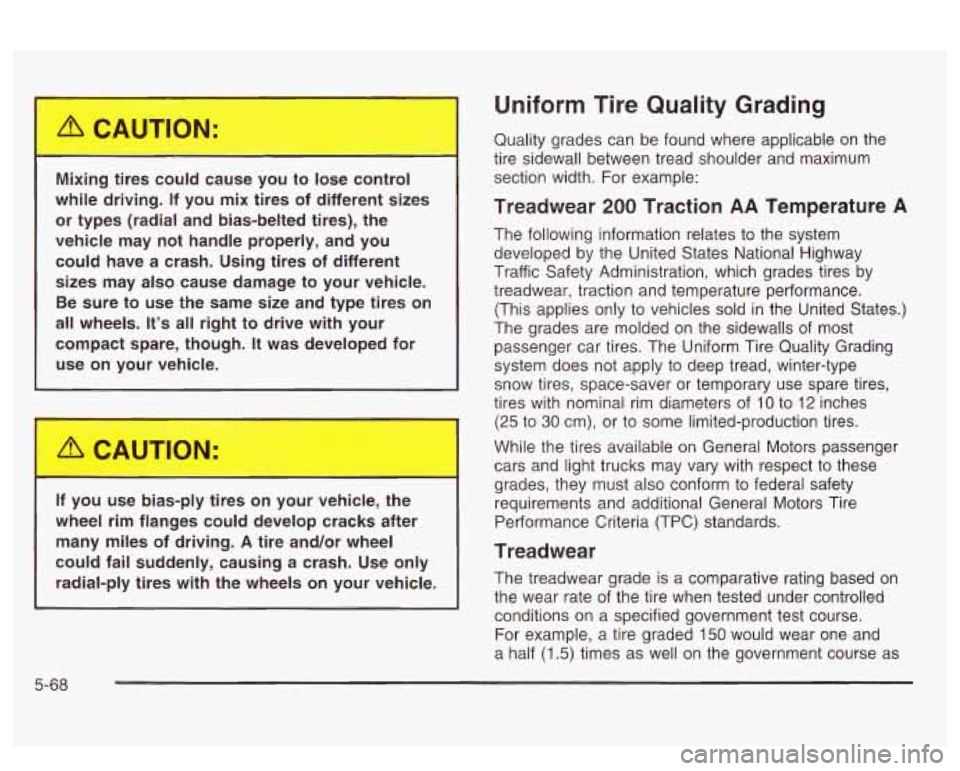
Mixing tires couh :ause you to lose control
while driving. If you mix tires of different sizes
or types (radial and bias-belted tires), the
vehicle may not handle properly, and you
could have a crash. Using tires of different
sizes may also cause damage to your vehicle.
Be sure to use the same size and type tires on
all wheels. It’s all right to drive with your
compact spare, though.
It was developed for
use on your vehicle.
I
If you use bias-ply tires on your vehicle, the
wheel rim flanges could develop cracks after many miles of driving.
A tire and/or wheel
could fail suddenly, causing a crash. Use only
radial-ply tires with the wheels on your vehicle.
5-68
Uniform Tire Quality Grading
Quality grades can be found where applicable on the
tire sidewall between tread shoulder and maximum
section width. For example:
Treadwear 200 Traction AA Temperature A
The following information relates to the system
developed by the United States National Highway
Traffic Safety Administration, which grades tires by
treadwear, traction and temperature performance.
(This applies only
to vehicles sold in the United States.)
The grades are molded on the sidewalls of most
passenger car tires. The Uniform Tire Quality Grading
system does not apply to deep tread, winter-type
snow tires, space-saver or temporary use spare tires,
tires with nominal rim diameters
of 10 to 12 inches
(25
to 30 cm), or to some limited-production tires.
While the tires available on General Motors passenger
cars and light trucks may vary with respect to these
grades, they must also conform
to federal safety
requirements and additional General Motors Tire
Performance Criteria (TPC) standards.
Treadwear
The treadwear grade is a comparative rating based on
the wear rate of the tire when tested under controlled
conditions on a specified government test course.
For example, a tire graded 150 would wear one and
a half (1.5) times as well on the government course as
Page 333 of 418
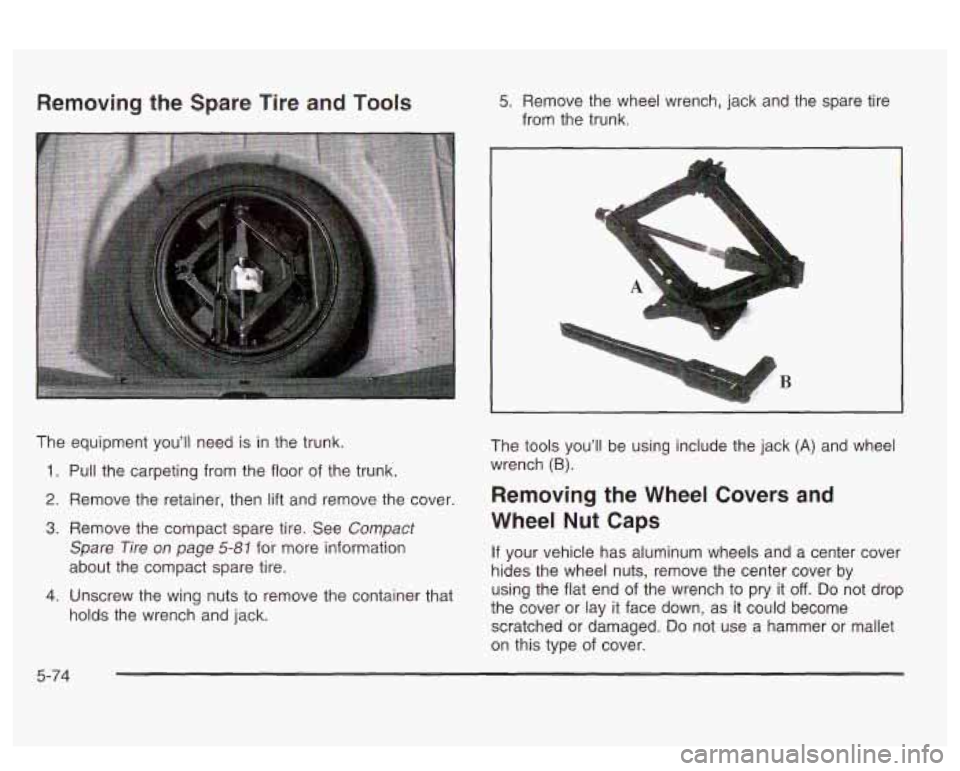
Removing the Spare Tire and Tools 5. Remove the wheel wrench, jack and the spare tire
from the trunk.
The equipment you’ll need is in the trunk.
1. Pull the carpeting from the floor of the trunk.
2. Remove the retainer, then lift and remove the cover.
3. Remove the compact spare tire. See Compact
Spare Tire on page 5-81 for more information
about the compact spare tire.
4. Unscrew the wing nuts to remove the container that
holds the wrench and jack. The
tools you’ll be using include the jack
(A) and wheel
wrench
(B).
Removing the Wheel Covers and
Wheel Nut Caps
If your vehicle has aluminum wheels and a center cover
hides the wheel nuts, remove the center cover by
using the flat end
of the wrench to pry it off. Do not drop
the cover or lay it face down,
as it could become
scratched or damaged.
Do not use a hammer or mallet
on this type of cover.
5-74
Page 334 of 418
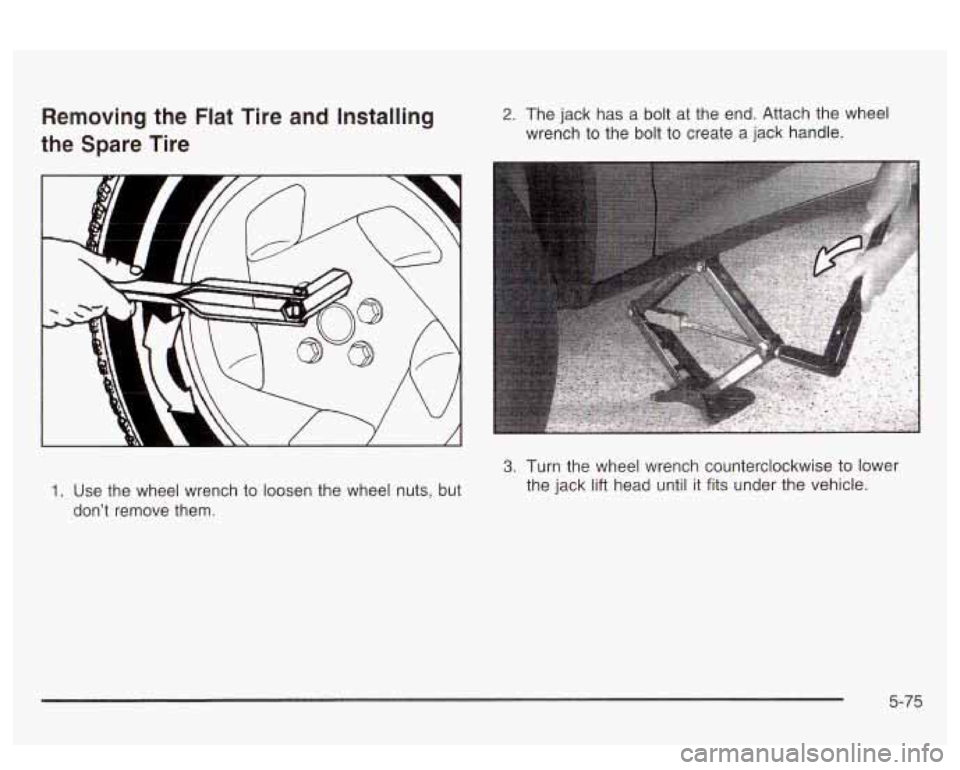
Removing the Flat Tire and Installing
the Spare Tire 2. The jack has a bolt at the end. Attach the wheel
wrench to the bolt to create a jack handle.
1. Use the wheel wrench to loosen the wheel nuts, but
don't remove them.
3. Turn the wheel wrench counterclockwise to lower
the jack
lift head until it fits under the vehicle.
5-75
Page 336 of 418
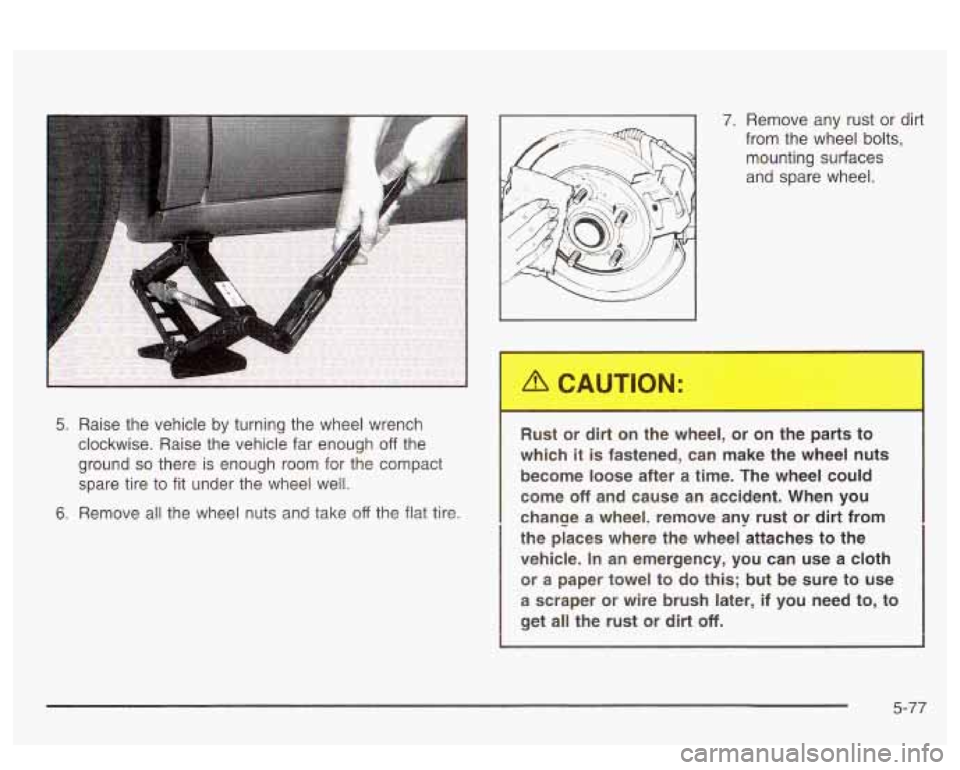
5. Raise the vehicle by turning the wheel wrench
clockwise. Raise the vehicle far enough
off the
ground
so there is enough room for the compact
spare tire to fit under the wheel well.
6. Remove all the wheel nuts and take off the flat tire.
7. Remove any rust or dirt
from the wheel bolts,
mounting surfaces
and spare wheel.
r
Rust or dirt on the wheel, or on the parts to
which
it is fastened, can make the wheel nuts
become loose after a time. The wheel could
come
off and cause an accident. When you
change a wheel, remove any rust
or dirt from
the places where the wheel attaches to the vehicle.
In an emergency, you can use a cloth
or a paper towel to do this; but be sure to use
a scraper or wire brush later,
if you need to, to
get all the rust or dirt
off.
5-77
Page 337 of 418
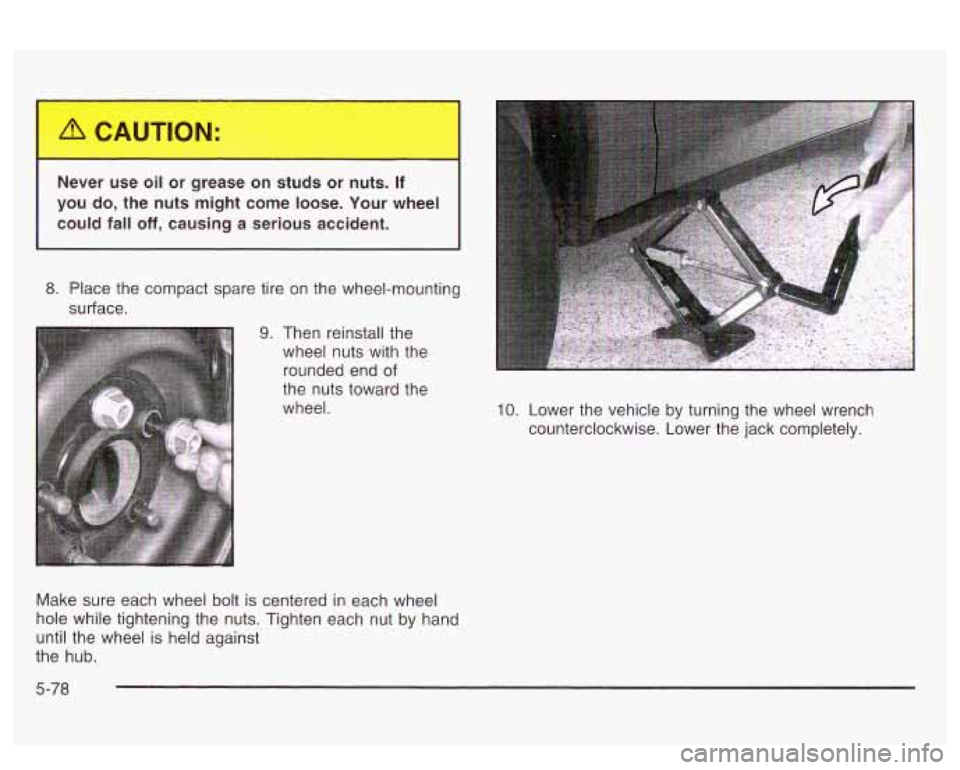
Never use oil or grease on studs or nuts. If
you do, the nuts might come loose. Your wheel
could fall
off, causing a serious accident.
8. Place the compact spare tire on the wheel-mounting
surface.
9. Then reinstall the
wheel nuts with the
rounded end
of
the nuts toward the
wheel.
10. Lower the vehicle by turning the wheel wrench
counterclockwise. Lower the jack completely.
Make sure each wheel bolt is centered in each wheel
hole while tightening the nuts. Tighten each nut by hand
until the wheel
is held against
the hub.
5-78
Page 338 of 418
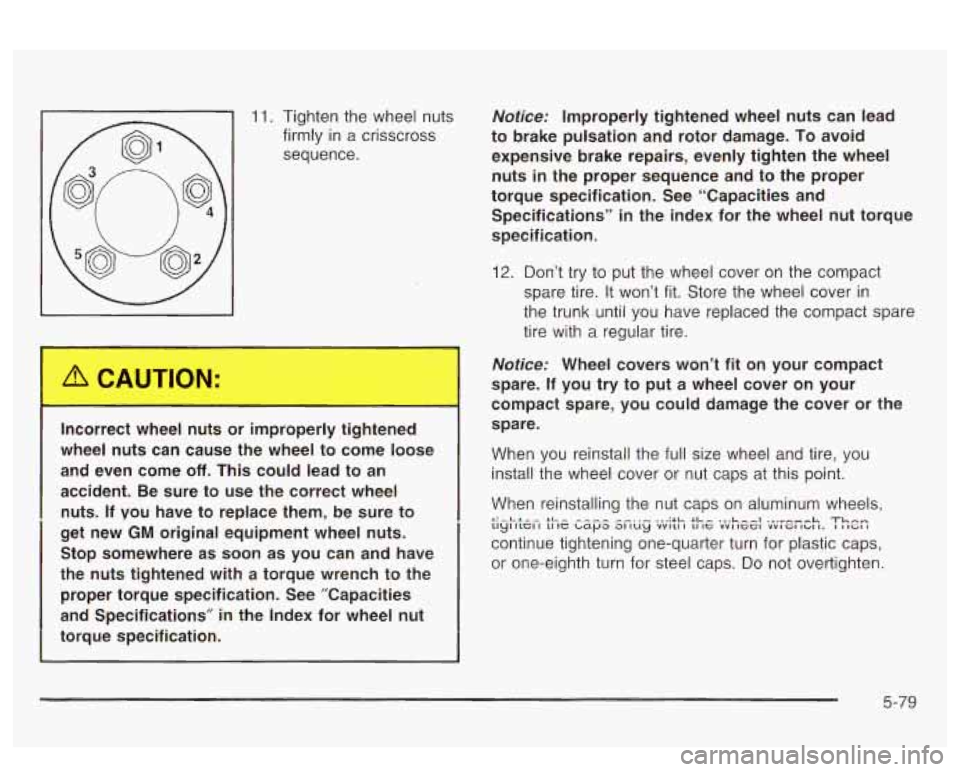
11. Tighten the wheel nuts
firmly in a crisscross
sequence.
Incorrect wheel nuts or improperly tightened
wheel nuts can cause the wheel to come loose
accident. Be sure to use the correct wheel
nuts. If you have to replace them, be sure to
get new
GM original equipment wheel nuts.
Stop somewhere as
soon as you can and have
the nuts tightened with a torque wrench to
the
proper torque specification. See ”Capacities
and Specifications”
in the Index for wheel nut
torque specification.
~ and even come off. This could lead to an
Notice: Improperly tightened wheel nuts can lead
to brake pulsation and rotor damage.
To avoid
expensive brake repairs, evenly tighten the wheel
nuts
in the proper sequence and to the proper
torque specification. See “Capacities and
Specifications”
in the index for the wheel nut torque
specification.
12. Don’t try to put the wheel cover on the compact
spare tire. It won’t fit. Store the wheel cover in
the trunk until you have replaced the compact spare
tire with a regular tire.
Notice: Wheel covers won’t fit on your compact
spare. If you try to put a wheel cover on your
compact spare, you could damage the cover or the
spare.
When you reinstall the full size wheel and tire, you
install the wheel cover or nut caps at this point.
When reinstalling the nut caps on aluminum wheels,
continue tightening one-quarter turn for plastic caps,
or one-eighth turn for steel caps.
Do not overtighten.
*:-.LA-.- AI-- --_- -_..- ..,:&I- &L- ..,L--l .-,v-mah llylllell tile Lapa a11uy vvlu I 11 IG VVIIGGI VVIGII’CIII. I IIGI I
5-79